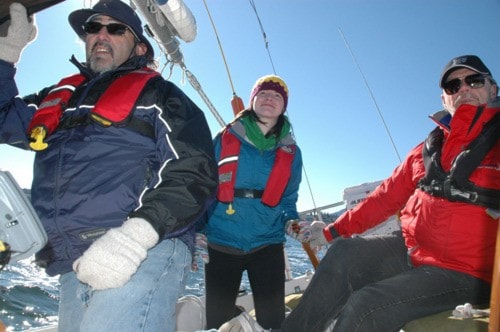Initial fears of making an utter fool of myself and getting seasick, falling overboard or simply steering the boat disastrously into the path of an oncoming seaplane aside, my first-ever taste of sailing was fairly … well, smooth sailing.
All hands remained on deck. No one retched over the rails. And the boat itself returned to dock intact.
Of course, while I did get a short stint at the helm and even got a crash course on tacking into the wind, much of the credit (OK, all of the credit) for not falling into the salt chuck, causing stomach somersaults or sinking the 27-foot Catalina go to my guides, Van-Isle Sailing Co-op’s Tony Sherer and Doug Mowatt, who agreed to take me and a friend out for a few hours on the water between Nanaimo and Gabriola on what turned out to be a gorgeous pre-spring day with a perfect mild breeze.
Sherer, a retired newspaper executive, is president of the six-year-old sailing co-operative, which boasts some six-dozen members from around its catchment area of the Nanaimo regional district.
The co-op is one of five such organizations in B.C., including one each in Vancouver and Victoria, and two in White Rock.
Co-operative boat ownership is a popular practice in the U.K. and throughout Europe, and was introduced in B.C. a quarter-century ago by George Doubter, who launched Vancouver’s Barnet Sailing Co-op.
After moving to Nanaimo, Doutre also founded the Van-Isle Sailing Co-op, which now has four vessels, all 27-foot crafts. The co-op model offers numerous benefits for its $405 annual membership fee ($475 for a family), not the least of which is affordable access to several boats year-round for a fraction of the cost (which ranges from mildly astounding to grotesquely astronomical) of owning a vessel individually.
Then there’s the opportunity to learn sailing at your own pace from experts with years of experience – Sherer earned his skipper’s ticket in 1980, while Mowatt, a mail carrier, got his in ’85, and they’re just two of the dozen or so qualified skippers in the group.
Of course, there’s also the social benefits of being among people with a similar interest or passion, and for the roughly dozen associate members who do own their own vessels outside the co-op, the opportunity to get a regular rotation of potential crew aboard their boats.
For regular members, their fees enable them to sail as much or as little as they like. And despite questions of vessel availability, Sherer says that much like privately owned vessels, the four boats sit at the dock more days than they’re on the water.
In fact, for hardy salts such as these two – who aren’t shy about sailing 12 months a year in virtually any condition (apparently, three boats were out earlier in the week on a regular ‘Winter Wednesday’ with stiff winds, a three-to five-foot chop and the boat occasionally completely heeled over and the sail ‘scooping green water’ (which apparently means catching gulps of ocean water, not just spray) – the co-op is extra beneficial.
“We’re quite happy to take peoples’ money so we can come out and sail all year,” Sherer jokes.
“There’s no problem getting out,” Sherer later adds as he jumps up to haul on a line raising the main sail. “For people like Doug and me, we can go almost whenever we want.”
With about a dozen skippers and an online reservation system for the four boats, it’s rare regular members can’t get a boat and skipper co-ordinated – Sherer says even in the peak summer season, the boats have about 50-60 per cent utilization (much higher than privately owned vessels, but still not so high as to restrict availability, in most cases).
But the co-op is mainly focused on getting more people sailing, or at least giving people the opportunity to try it without breaking their bank accounts.
“By co-operative ownership, basically it’s just to keep the cost down,” says Sherer.
“It’s not a sailing club, it’s a co-op. We want people to enjoy this and learn to sail and be competent and safe.”

While I don’t feel entirely competent as I take my nervous turn at the helm, I do feel safe under the watchful eye of my two guides, who tell me my white-knuckle handle on helm is not uncommon for first-timers.
“Everyone has a death grip there first time out,” Mowatt assures me, though I’m not entirely convinced.
Still, the pair’s subtle suggestions and patient guidance help me (once I get a handle on the sailing nomenclature) steer the little boat safely past a few massive anchored container ships into Nanaimo harbour.
And then Mowatt tells me we’re going to tack.
Cue the return of the death grip.
Yet, even with my heart in my throat and my mind envisioning our inevitable collision with the crab dock off Maffeo Sutton Park, Mowatt and Sherer both appear completely cool as they talk me through the tacking process and the associated commands (which I manage to garble once, twice, thrice ... ) a half-dozen times until I’m still not even remotely approaching competent at the helm, but might pass for marginally comfortable. If nothing else, my full white-knuckle death grip has relaxed a little and might now be classed instead as firm choke hold.
Apparently, my ear-to-ear grin is also telling as to my increasing level of comfort.
After a few more tacks with my friend taking a turn at the helm, we haul in the sails and motor leisurely back to the marina, where we leave Sherer and Mowatt to secure the boat and ready it for its next trip out.
More information about the Van Isle Sailing Co-op is available by e-mailing coopinfo@visail.ca.
